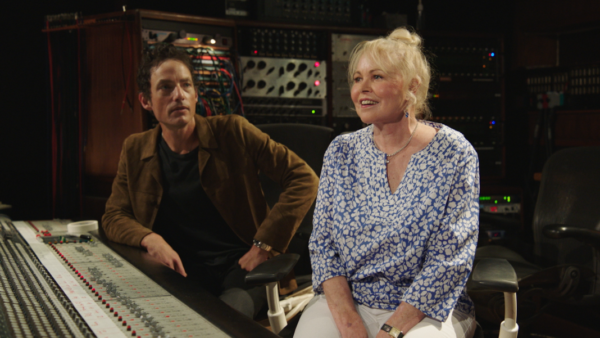Film Review: “Echo in the Canyon” — LA’s Land of the Giants
By Gerald Peary
Echo in the Canyon is for me, an incurable 1960s nostalgic, a sublimely moving documentary celebration of this nonpareil moment when, a half century ago, the Southern California scene boasted giants of music like The Byrds, Buffalo Springfield, the Mamas and the Papas, and the Beach Boys.
Echo in the Canyon, Screening at Landmark Kendall Square Cinema and Coolidge Corner Theatre.

Jakob Dylan and the Mamas and the Papas’ Michelle Phillips in “Echo in the Canyon.” Photo: Mirror Films.
Though only a couple of blocks off of Hollywood Boulevard, Laurel Canyon is not what you think of when you conjure up LA: a self-contained trippy neighborhood of deep ravines and winding roads, funky houses on the sides of hills. In its glory days, c.1965-1967, it was the epicenter of American rock’n’roll, populated by remarkably gifted musicians who wrote and jammed together, did psychedelics together, definitely balled together, and produced, live and on LPs, boundless, seemingly effortless transcendent music. Echo in the Canyon is for me, an incurable 1960s nostalgic, a sublimely moving documentary celebration of this nonpareil moment when, a half century ago, the Southern California scene boasted giants of music like The Byrds, Buffalo Springfield, the Mamas and the Papas, and the Beach Boys.
Give credit to executive producer, Jakob Dylan, also Echo in the Canyon’s main on-screen presence, for being the architect of this documentary of many ambitions, though the pieces are melded together by filmmaker Andrew Slater. There’s a mini-history of the Laurel Canyon saga that blends juicy historic 1960s footage of the legendary bands and current-day interviews with their surviving members. More, there’s a tribute concert organized again by Dylan, in which a host of today’s celebrity musicians come together for a night of recreating 1960s songs by the LA legends. Finally, there’s a filming of the concert, with footage included in this all-inclusive film.
In conducting the interviews, Dylan (Bob’s son) is serious-minded and respectful, mostly nodding while the rockers tell their racy, enticing stories. As a singer here, Jakob Dylan is equally modest in performing the old songs as straight homage, not transforming them for the new millennium. There’s nothing idiosyncratic about his approach to the material, just nice strumming and singing, the antithesis in approach to his ever-weird dad.
Speaking of Bob Dylan. He’s relevant to the Laurel Canyon story because of what Roger (then Jim) McGuinn and the Byrds did to his “Mr. Tambourine Man,” electrifying it and beautifying it, turning it into an instant classic of a new West Coast genre, folk rock. The Byrds did it a second time, making gentle rock’n’roll out of Pete Seeger’s folkie “The Bells of Rhymney. “ Then there was the Beach Boys rendition of “The Sloop John B,” a Bahaman folk ditty earlier popularized by the acoustic-based Kingston Trio. The California sound: folk music elevated by electrified instruments and extraordinary three- or four-part harmonies. Finally, when the LAers penned their own songs: self-consciously poetic lyrics. No more, “Oh oh, I love you so, I can’t ever let you go.” Instead: the Mamas and Papas’ sinuous “California Dreaming,” the Beach Boys’ exquisitely private “In My Room,” The Buffalo Springfield’s masterly anti-Vietnam War tome, “For What It’s Worth.”
What you have with the LA sound, not discussed in the movie: the loveliest, most lyrical, white rock’n’roll. Here is music without a moment of African-American sound anywhere, sans the blues in any manifestation. The biggest conscious influence: the Beatles, not the Stones in any way. And there was cross-fertilization. The Beatles welcomed the Byrds to London. Rubber Soul pushed Brian Wilson and the Beach Boys to the amazing Pet Sounds. And Pet Sounds challenged the Beatles to get far deeper with Sergeant Pepper’s Lonely Hearts Band.
The tribute concert sampled here is a good one, with Jakob Dylan and Beck joined by a flock of potent women singers. They steal the show a bit: Jade, Cat Power, Fiona Apple, Regina Spektor, Norah Jones. But Echo in the Canyon is really made by the interviews, enthusiastic ones (Stephen Sills, John Sebastian, Graham Nash, Roger McGuinn) and raunchy ones (Michelle Phillips, David Crosby). Phillips tells with guilt-free relish how she almost broke up the Mamas and Papas by cheating on her husband, John Phillips, with Denny Doherty, the other male member of the group. The famously licentious Crosby wrote a song rejected by the others in the Byrds because it applauded his propensity for threesomes. Why was he kicked out of the band? “Because I was an asshole,” Crosby declares.
Finally, one interview really hurts. It’s with Tom Petty. For forty years with the Heartbreakers, the Floridian was the greatest purveyor of the California Sound. He reinvigorated the jingle-jangle Byrds for today’s sensibilities. Here, Petty is so smart, articulate, and in such fine spirits, and he seems in excellent health. He must have died within months after sitting down with Jakob Dylan to chat so happily about the golden 1960s.
Gerald Peary is a Professor Emeritus at Suffolk University, Boston, curator of the Boston University Cinematheque, and the general editor of the “Conversations with Filmmakers” series from the University Press of Mississippi. A critic for the late Boston Phoenix, he is the author of nine books on cinema, writer-director of the documentaries For the Love of Movies: the Story of American Film Criticism and Archie’s Betty, and a featured actor in the 2013 independent narrative Computer Chess. He is currently at work co-directing with Amy Geller a feature documentary, The Rabbi Goes West.
